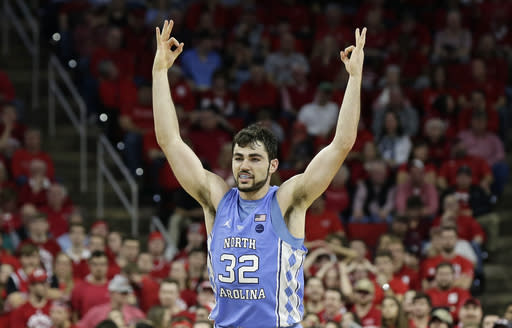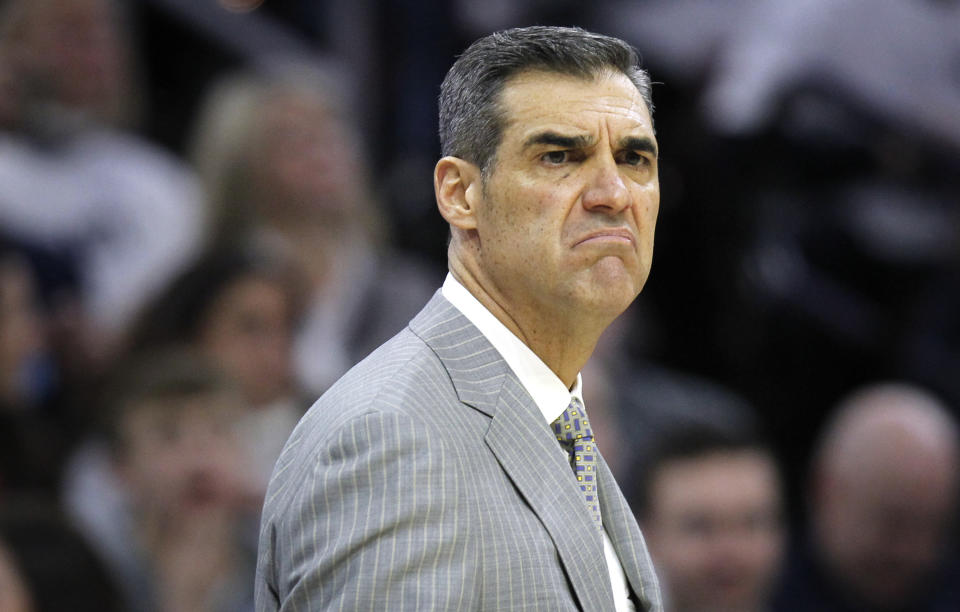Forde Minutes: How Oklahoma's Trae Young lost his grip on Player of the Year
Forty names, games, teams and minutiae making news in college basketball (panic buttons sold separately in Lexington, Kentucky):
More Minutes: Biggest surprises of this college hoops season
FIRST HALF: HOW TRAE YOUNG LOST HIS GRIP ON PLAYER OF THE YEAR
There is a savage tendency within college basketball to eat our young — to elevate highly recruited freshmen to savior levels, then methodically deconstruct them as the season wears on.
It’s not necessarily fair, but this is the state of the sport. The top talents are babies, and they have an eye on the quickest possible path to the NBA, and so they get the attention — especially when they perform well early. But then the rigors of conference play set in, and the dog days of February are upon us, and when the 18-year-olds struggle the cannibalism commences.
All of which is to say, welcome to the boiling pot, Trae Young (1).
The Oklahoma point guard is piloting a team that has lost three in a row and six of its last eight. The Sooners are 16-8 overall, 6-6 in the Big 12. And suddenly Young, the revelation of November, December and early January, is having his national Player of the Year credentials revoked in some circles. It’s still too early to say who should win the various POY awards, but here’s what has gone awry for Young in recent weeks:
* First and foremost, his team is losing (2). Team success is a major part of the equation for individual awards, which is how it should be in a team sport. If Oklahoma finishes anywhere in the neighborhood of .500 in league play, it would make Young an unprecedented POY winner. The Naismith Player of the Year award has been in existence since 1969, and the winner’s team has never been close to .500 in conference play. (Some were from independent teams which did not play in conferences.) Only one winner, Andrew Bogut of Utah in 2005, was part of a team seeded lower than fourth in the NCAA tourney — the Utes were a No. 6 seed. (Teams were not publicly seeded prior to 1979.)

* Second, Young’s pace of production was unsustainable (3). He just wasn’t going to continue shredding everyone at the same efficiency rate when conference play hit. Oklahoma’s season divides neatly into 12-game halves at the moment, and while Young’s scoring is virtually identical first half (29.6 points per game) to second half (29.5), his assists are down (10.7 to 8.1) and turnovers are up (4.1 to 6.6). Three-point accuracy has dipped (41.3 percent to 35.9) as well. He’s playing against better defenses and against teams that have spent more time scouting him. It’s harder now.
* He is not a good defensive player (4). That doesn’t necessarily distinguish him from a lot of other freshmen, but Young is one of the weakest links on a weak defensive team.
* Oklahoma was camouflaging a lack of talent (5). Young’s brilliance and Lon Kruger’s coaching made the Sooners look better than they were for a long time. But it’s hard for a group to collectively play over its head all season, and this looks like a team that has come back down to Earth in recent weeks.
So if Young is no longer a lock POY, who else should be considered? Here’s the list:
Marvin Bagley III (6), Duke. Why: Leads the Atlantic Coast Conference in both scoring (21.5 points per game) and rebounding (11.4), and is second in field-goal percentage (.599). After reclassifying into this freshman class, Bagley has been even better than advertised. Hold the hype: Duke just broke a two-game losing streak and played one of its better halves of the year Sunday without Bagley, routing Georgia Tech.
Keita Bates-Diop (7), Ohio State. Why: The biggest reason why the Buckeyes are the surprise leader of the Big Ten is the 6-foot-7 Bates-Diop, whose game has exploded as a redshirt junior. He scored 600 points his first three seasons of college and 538 this year, and his career rebounding average has morphed from 4.3 his first three seasons to 9.0 this year. He’s been the hub of everything first-year coach Chris Holtmann has devised, producing 10 double-doubles so far. Hold the hype: The Buckeyes have played the easiest schedule in an easy Big Ten, which can inflate some stats.
Jalen Brunson (8), Villanova. Why: Most consistent player on the most consistent team in the country. Brunson has just the right combination of prudence and fearlessness, willing to drive into anything but unwilling to hoist many forced shots — which is why he’s shooting 45 percent from 3-point range and 61 percent inside the arc. The point guard also has never had more than three turnovers in a game this year, which stands out in comparison to Young’s turnover numbers. Hold the hype: Brunson’s highlight reel isn’t going to look much like Young’s, Bagley’s or Deandre Ayton’s. Not a lot of sizzle in the game.
Deandre Ayton (9), Arizona. Why: Jaw-dropping physique and skill set, with production that is a virtual match for Bagley’s: 19.5 points, 10.7 rebounds, 60.4 percent shooting from the field. When he steps out and shoots 3s (34.5 percent for the season), it’s unfair. Hold the hype: At 7-1 and 260 pounds, he’s not yet an elite rim protector, averaging 1.8 blocks per game on the back line of a lackluster defensive team.
Luke Maye (10), North Carolina. Why: A 33-point, 17-rebound performance against NC State last week got everyone’s attention. And if the Tar Heels extend their current three-game losing streak further in the coming weeks, Maye will get more buzz. He’s had seven games with more than 25 points and five with more than 15 rebounds thus far, and at 48 percent from 3-point range the 6-8 junior post player is one of the most difficult matchups in the country. Hold the hype: Is Maye even the most important Tar Heel? Or is it guard Joel Berry?

TURNOVER AT THE TOP
If you want to understand the tumult in college basketball, look no further than the current standings in the six best conferences. Then check the standings from the end of last season. Staying on top is hard. The rundown:
Atlantic Coast (11). Last year: North Carolina. This year: Virginia. As it currently stands, neither the Tar Heels nor Duke are in the top two. If it stays that way through the end of the regular season, it would be just the second time in the last 22 years that Duke and Carolina both finished third or lower in the ACC (the last time: 2014).
Big 12 (12). Last year (and all the previous years, dating back to 2004): Kansas. This year: Texas Tech. The Jayhawks already have lost three league games at home and four overall. They’ve only lost more than four in Big 12 play once under Bill Self (2015), but that could happen with a challenging schedule down the stretch.
Big Ten (13). Last year: Purdue. This year: Ohio State. The Buckeyes surprised just about everyone by falling behind Purdue by double digits in Mackey Arena last week and rallying to win. But three of the last four are on the road for Ohio State, which could make it tough to maintain the current one-game edge over the Boilermakers.
Big East (14). Last year: Villanova. This year: Xavier. The Musketeers are only a half-game ahead of ‘Nova at the moment, but have a chance to avenge a Jan. 10 loss to the Wildcats at home Saturday. That game will all but decide the regular-season champion.
Pac-12 (15). Last year: Oregon and Arizona tied for the regular-season title, but Oregon was the No. 1 seed for the conference tournament by virtue of a head-to-head win over the Wildcats. This year: Arizona. The Wildcats have a two-game lead on USC and UCLA, but the next three are on the road — starting Thursday with a rematch of a Dec. 30 classic against rival Arizona State.
SEC (16). Last year: Kentucky. This year: Auburn. The Tigers, up two games on Tennessee and Florida, haven’t been in this position since 1999. But there could be a couple of losses on the horizon, especially if leading scorer Bryce Brown remains limited with a shoulder injury. (He did return to practice Monday, with Kentucky coming to town on Wednesday.)
CIRCLE OF TRUST, WEEK TWO
Making the Final Four is one thing. Winning a national title is something altogether different. Each week, The Minutes will list the teams in the Circle of Trust that are reliable championship candidates — the kind you can write with confidence on that last blank line in your NCAA tournament pool.
For the second straight week, the number of the teams in the Circle of Trust is one: Villanova (17). And let’s just say the Wildcats didn’t do much to deepen The Minutes’ trust with a shocking home loss to St. John’s last week. But once you’re in the circle, you can stay in the circle — unless the wheels really come off.

The Minutes did put a second team under Circle consideration: Michigan State (18). But not yet. The Spartans were very impressive in beating Purdue in a high-level game Saturday, but it also was a home game. And quite frankly, Michigan State probably has two wins all season over likely NCAA tournament teams: North Carolina in November and the Boilermakers last week. The Spartans have all the pieces, but not yet all the résumé for Circle of Trust inclusion.
GULAG OF DISTRUST
The Minutes is adding a new feature: Teams that absolutely are not to be trusted, but are too talented to completely disregard. Two Southeastern Conference teams have been assigned to the gulag until further notice:
Kentucky (19). The Wildcats are playing lousy basketball, riding a three-game losing streak and flukishly lucky it’s not four (Vanderbilt utterly botched the end of regulation in Rupp Arena Jan. 30). Kentucky doesn’t shoot well (28.7 percent from 3 in league play), doesn’t pass well (other than Shai Gilgeous-Alexander), doesn’t get back on defense and generally seems more like a loose confederation of athletes than a cohesive team. And yet … there is NBA talent and NBA size on the roster. And regardless what the nervous fan base is saying, Kentucky is still safely in the NCAA tournament right now. If the ‘Cats simply get in the field, will anyone relish playing them?
Alabama (20). This has become America’s bipolar team. The Crimson Tide looked bad in a 12-point loss to Mississippi — then took down Oklahoma five days later. They followed that with a flop at home against Missouri — then routed Florida on the road four days later. That was followed by a dismal loss to Mississippi State — then ‘Bama destroyed Tennessee five days later. Basically, the Tide are a weeknight zero and a weekend hero. If they ever discover consistency, this also is a team with sufficient athleticism to be a difficult out at tournament time.

